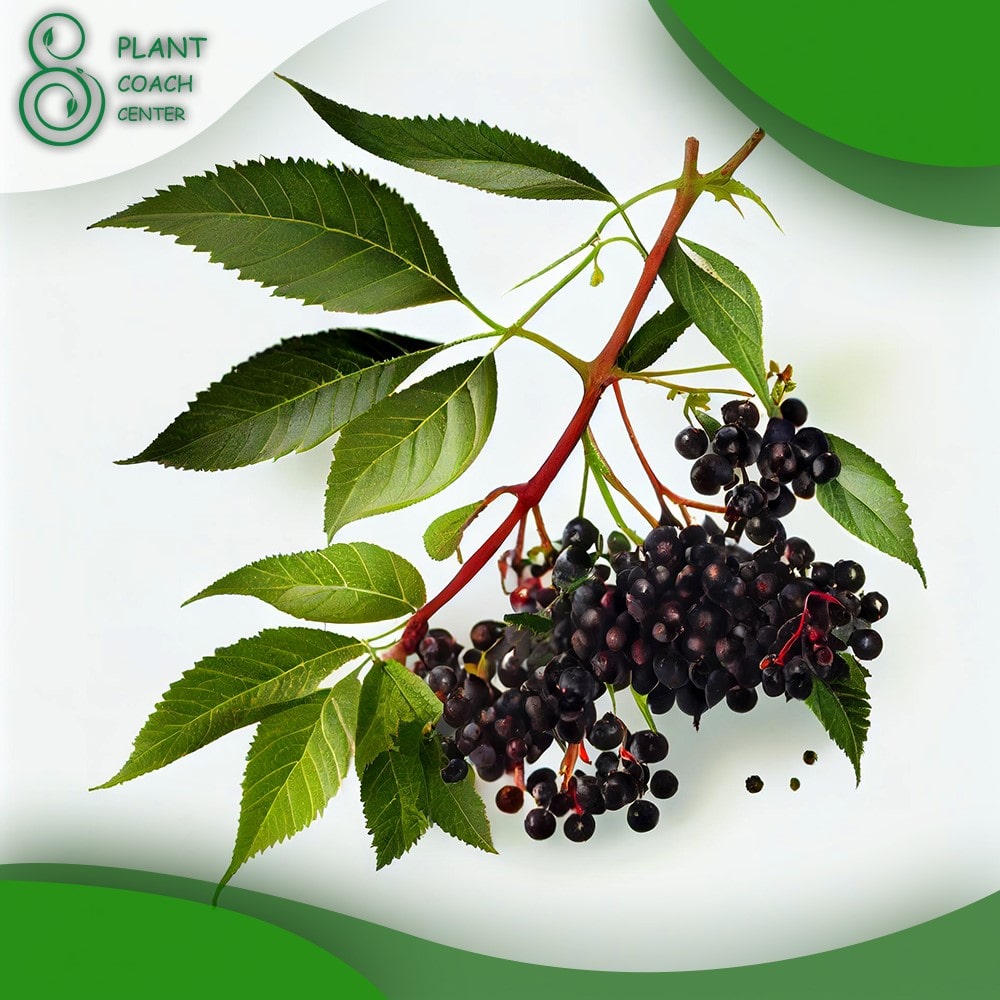Introduction to When to Prune Elderberry
Elderberry plants, with their clusters of small, dark berries, are a staple in many home gardens. They’re not only a delight to the taste buds but also pack a punch of health benefits. However, to ensure your elderberry plants thrive and yield bountiful harvests, you need to know when to prune them. In this article, we’ll delve into the art of elderberry pruning, with a particular focus on timing.
In this article of plantcoachcenter.com , We’ll explore the life cycle of elderberries, the pivotal role pruning plays in their health, and the two primary windows of opportunity for pruning: early spring and late fall. By understanding when to pick up your pruning shears, you’ll be on your way to nurturing vigorous elderberry bushes and enjoying the rewards of your efforts. So, let’s get started on the journey to mastering the art of timing when it comes to pruning elderberry!

Understanding Elderberry Growth
Description of Elderberry Plant Characteristics
Elderberry plants (Sambucus spp.) are deciduous shrubs or small trees known for their distinctive features. These hardy plants typically reach heights between 5 to 15 feet and boast an erect, multi-stemmed growth habit. Their pinnately compound leaves, composed of 5 to 11 leaflets, are bright green and serrated along the edges. During spring, elderberries don white or cream-colored clusters of fragrant flowers, which later transition into the familiar bunches of dark purple-black berries in late summer or early fall.
Elderberry bushes are characterized by their vigorous growth and sprawling nature, often forming dense thickets if left unchecked. These plants are known for their adaptability to various soil types, thriving in both moist, well-drained soils and moderately dry conditions.
Lifecycle Stages of Elderberry
Understanding the lifecycle of elderberry is pivotal for successful pruning. These plants follow a predictable sequence:
Dormancy (Winter): During the winter months, elderberries enter a period of dormancy. At this stage, the plant’s energy is focused inward, conserving resources for the coming growth season. This is the ideal time for rejuvenative pruning.
Bud Break (Early Spring): As temperatures rise in early spring, elderberry bushes awaken from dormancy, and new buds begin to swell and break. This marks the onset of active growth, making it a crucial time for early spring pruning.
Flowering (Late Spring): In late spring, elderberries produce large, fragrant clusters of white or cream-colored flowers. These flowers eventually give way to developing fruit clusters.
Fruit Development (Summer): The berries start to ripen in summer and reach their peak in late summer or early fall. This is when the elderberry bush invests heavily in fruit production.
Dormancy (Late Fall): As winter approaches, elderberry plants prepare for dormancy once again. Late fall offers an alternative window for pruning but requires specific considerations.
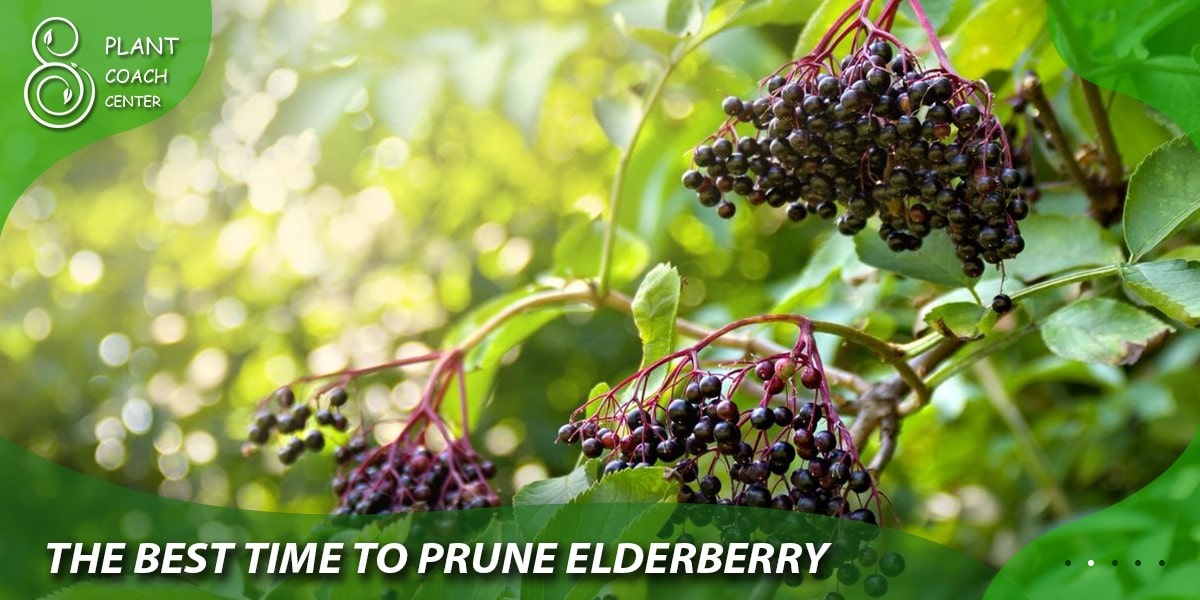
The Role of Pruning in Elderberry Maintenance
Pruning is a vital component of elderberry plant care. It serves several purposes, such as removing dead or diseased wood, improving air circulation, and maintaining an open canopy. By reducing the number of older, unproductive canes and promoting the growth of vigorous young canes, pruning contributes to overall plant health and fruit production.
Moreover, pruning influences the timing of flowering and fruiting. Properly timed pruning can stimulate the development of strong fruiting wood, resulting in more abundant and accessible elderberries. Understanding the growth stages of elderberry is essential for making informed decisions about when and how to prune, ensuring that you harness the full potential of these versatile plants in your garden.
The Best Time to Prune Elderberry
Early Spring: Ideal Timing for Pruning Elderberry
Why Early Spring is Preferred
Early spring, when your elderberry bushes are just beginning to stir from their winter slumber, stands out as the prime time for pruning. There are compelling reasons for this choice:
Dormancy Transition:
As winter loosens its grip and temperatures rise, elderberries transition from dormancy to active growth. This shift signals the plant’s readiness to allocate resources towards new growth, making it the ideal moment for pruning.
Disease Prevention:
Early spring pruning helps remove any dead or diseased wood that may have accumulated during the dormant season. By doing this before new growth fully emerges, you reduce the risk of spreading diseases and pathogens.
Stimulating Growth:
Pruning in early spring encourages the development of vigorous new canes. This fresh growth is where your elderberry plant’s energy will be directed, resulting in a more productive and fruitful plant.
Identifying the Right Time in Early Spring
Determining precisely when to prune in early spring is crucial for success. Look for these indicators:
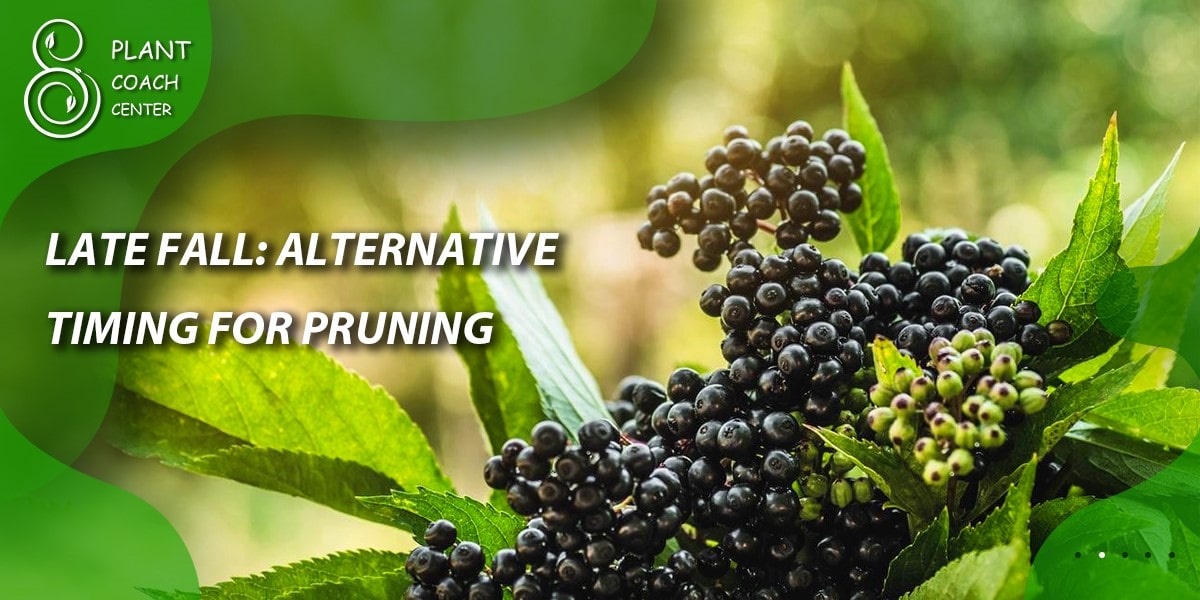
Bud Swelling:
Monitor your elderberry bushes for signs of bud swelling. You want to prune just before the buds start to break open. The buds should appear plump and ready to burst but haven’t done so yet.
Flexible Canes:
Test the canes by gently bending them. If they flex easily without snapping, it’s a good sign that they’re in the optimal stage for pruning. Rigid, brittle canes should be left alone.
Late Fall: Alternative Timing for Pruning
When Late Fall Pruning Might be Necessary
While early spring is the preferred time for pruning elderberries, late fall can be considered when specific circumstances arise:
Disease Management:
If your elderberry bushes have suffered from diseases like powdery mildew or bacterial canker during the growing season, late fall pruning can help remove infected wood and prevent the diseases from overwintering.
Overcrowding:
In situations where elderberry thickets have become overly crowded, late fall can be an opportunity to thin them out. Removing excess canes can improve air circulation and overall plant health.
Precautions for Late Fall Pruning
Late fall pruning does come with some caveats:
Weather Considerations:
Ensure that you prune well before the first frost. Late fall pruning leaves fresh wounds vulnerable to frost damage, which can be detrimental to the plant.
Selective Pruning:
Focus on the removal of dead or diseased wood and avoid heavy pruning in late fall. The goal is to tidy up the plant rather than stimulate significant new growth.
In summary, early spring is the prime time for pruning elderberry, aligning with the plant’s natural growth cycle and offering the best results for overall health and productivity. Late fall pruning can be a solution for specific issues but should be approached with caution to avoid harming the plant in colder weather. By understanding the nuances of timing, you’ll ensure your elderberry bushes thrive and continue to bear the delicious fruits you love.

Benefits of Pruning Elderberry at the Right Time
Pruning elderberry plants at the correct time isn’t just about taming unruly foliage; it’s a strategic horticultural move with a host of compelling advantages that transform your garden into a thriving elderberry haven.
Encouraging Vigorous Growth
When you trim your elderberry bushes at the optimal moment, typically in early spring, you’re sending a clear signal to the plant that it’s time to invest in fresh, robust growth. By removing old and worn-out canes, you’re redirecting the plant’s energy towards the development of new, vibrant shoots. This leads to an increase in the number of productive canes and ultimately results in a denser and healthier elderberry bush.
Increasing Fruit Production
Pruning is like whispering sweet encouragement to your elderberry bushes, coaxing them to bear more fruit. By eliminating unproductive canes and focusing the plant’s resources on the young, fruit-bearing ones, you’ll witness a significant boost in fruit production. Those clusters of dark, juicy elderberries you love so much? Pruning plays a pivotal role in ensuring their abundance.
Preventing Diseases and Pests
Pruning isn’t just about shaping your elderberry plant; it’s also a defense strategy. Early spring pruning, in particular, allows you to identify and remove any diseased or pest-ridden wood before the growing season kicks into high gear. This proactive measure can be a game-changer in preventing the spread of diseases like powdery mildew and thwarting the ambitions of garden pests.
Enhancing Overall Plant Health
Picture this: a well-pruned elderberry bush, its canopy basking in sunlight, and air circulating freely through its branches. This scenario isn’t just aesthetically pleasing; it’s the epitome of elderberry plant health. Pruning contributes to this picture by improving air circulation and reducing the risk of moisture-related issues. It also prevents overcrowding, ensuring that each cane gets its fair share of nutrients and sunlight.
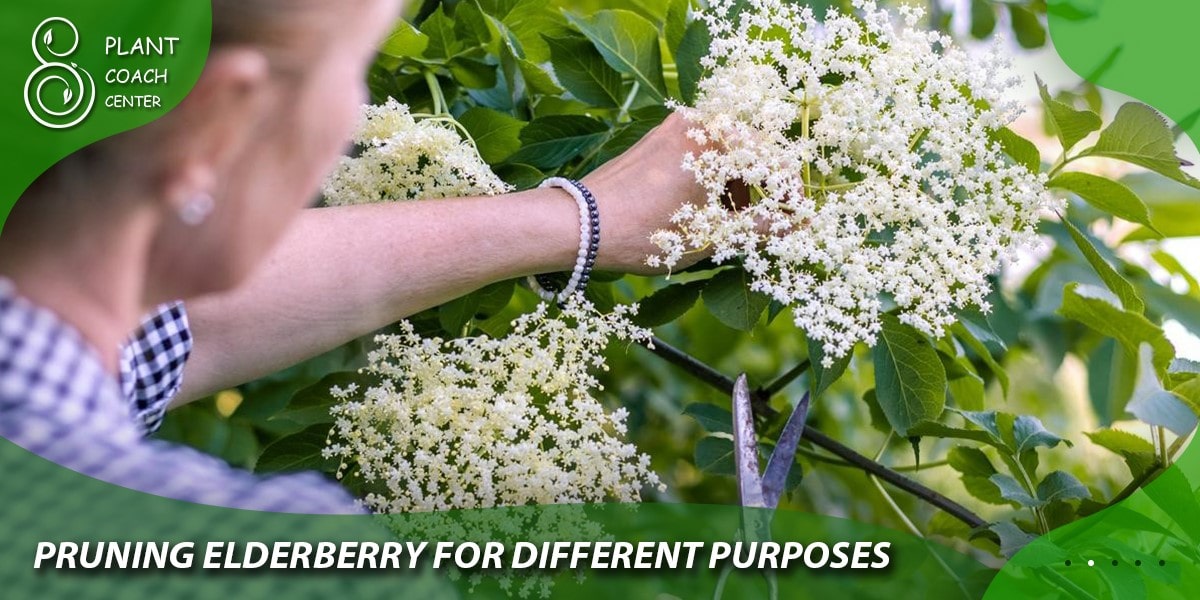
In essence, pruning elderberry at the right time is akin to a tailored wellness plan for your plants. It promotes vigorous growth, multiplies fruit yields, fortifies defenses against diseases and pests, and nurtures overall plant vitality. It’s a relatively simple task with profound rewards, transforming your garden into a flourishing elderberry sanctuary. So, when the pruning season rolls around, seize the opportunity to cultivate the best possible conditions for your beloved elderberry plants.
Pruning Elderberry for Different Purposes
Pruning for Fruit Production
Timing: Early spring, right before bud break, is the gold standard for those seeking a bumper crop of elderberries. Pruning during this period encourages the growth of new canes, which are the primary producers of flowers and, subsequently, fruit.
How: Trim back the older, unproductive canes to ground level, allowing fresh canes to take center stage. Aim for a balanced canopy with sufficient spacing between canes to ensure optimal sunlight penetration and airflow.
Pruning for Plant Health
Timing: Regular maintenance pruning can occur throughout the year, but the most significant work should be reserved for early spring. This period allows you to address dead, diseased, or damaged wood before new growth begins.
How: Start by removing any dead or diseased canes, cutting them down to the base. Also, thin out overcrowded areas to enhance air circulation and light exposure. Focus on maintaining an open canopy structure for overall plant health.
Pruning for Aesthetic Appeal
Timing: Elderberry bushes can be pruned for aesthetic purposes in late winter or early spring before bud swell. However, it’s essential to strike a balance between aesthetics and the plant’s health and fruit production needs.
How: To achieve a pleasing shape, trim the outermost canes lightly and shape the plant as desired. Be cautious not to remove too much, as this can negatively impact fruit production and plant vitality.
Rejuvenation Pruning
Timing: If you have an older elderberry bush that’s become overgrown or less productive, consider rejuvenation pruning during late winter or early spring.
How: Cut the entire elderberry bush back to within a few inches of the ground. While this may seem drastic, it can invigorate the plant, encouraging fresh, vigorous growth. Be prepared for a season without elderberries, as the plant rebuilds its structure.
In essence, the timing of your elderberry pruning depends on your objectives. Whether it’s a bountiful harvest, robust plant health, an attractive garden feature, or a complete rejuvenation, aligning your pruning schedule with your goals will help you reap the best results from your elderberry plants.
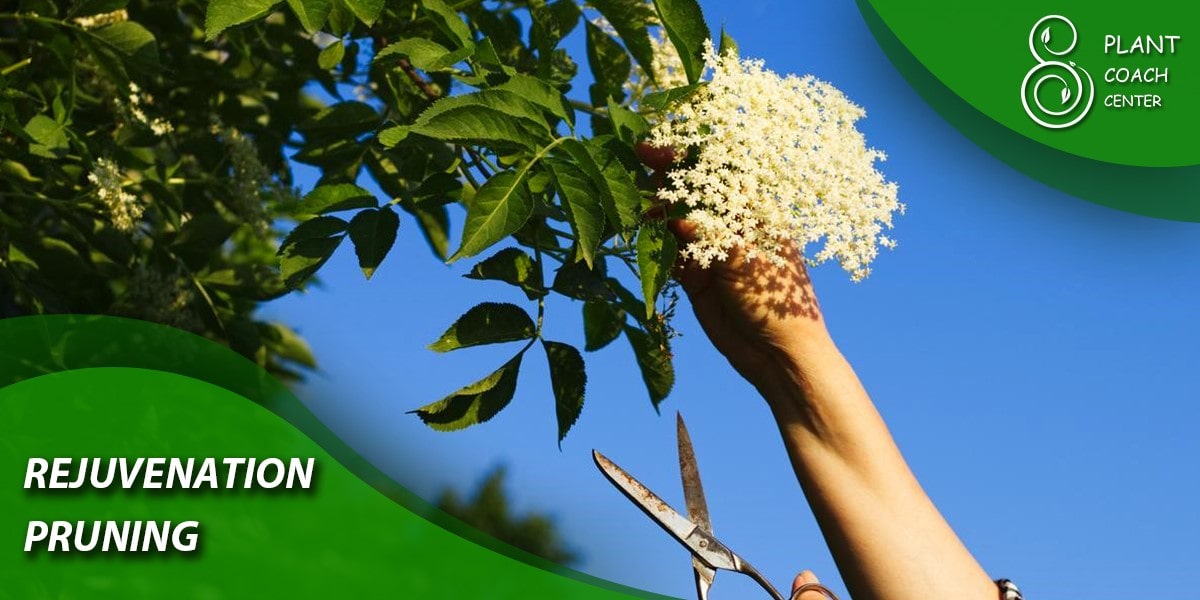
Conclusion
In the world of gardening, timing is everything, and pruning elderberry plants is no exception. As we’ve explored the intricacies of when to prune elderberries, it’s become abundantly clear that this timing plays a pivotal role in the health, productivity, and overall vitality of these remarkable shrubs. From the rejuvenating touch of early spring to the cautious embrace of late fall, the timing of your pruning efforts is a critical factor in the success of your elderberry garden.
With this knowledge in hand, we encourage gardeners to embrace the art of elderberry pruning. Take the time to understand the growth cycle of your plants, the signs of readiness, and the techniques required to shape them optimally. By doing so, you’re not only caring for your elderberry bushes but also unlocking the full potential of their delicious bounty.
And as you witness the satisfying results of correctly timed pruning – the explosion of fresh growth, the abundance of plump, juicy elderberries, and the overall resilience of your elderberry plants – you’ll find that the effort invested is well worth the reward. So, step into your garden with confidence, shears in hand, and let the dance of timing and pruning transform your elderberry patch into a thriving and fruitful oasis. Happy gardening!
FAQs
When is the best time to prune elderberry?
Early spring, just before bud break, is ideal.
Can I prune my elderberry in late fall?
Yes, but exercise caution and avoid frosty conditions.
How do I encourage more fruit production?
Prune for fruit in early spring, focusing on productive canes.
What if my elderberry bush is overgrown?
Consider rejuvenation pruning in late winter or early spring.
Can I prune for aesthetics?
Yes, but balance aesthetics with plant health and fruit goals.
Why is pruning important for elderberry plants?
Pruning improves health, increases yields, and prevents disease.


